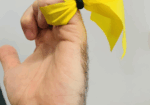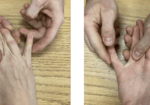Should we still be immobilizing the thumb in scaphoid fractures, or is a wrist-only cast just as effective?
Filed under Orthoses
Article:
Harper, K. J., Rees, Y., Tan, N. X., Li, H., Fonseca, E. A., Quach, P. G., Lee, G. S., Brayshaw, J.
R., & McGarry, S. (2025). Determining the success of clinical outcomes for thumb
immobilization compared to no thumb immobilization in adult non-displaced, non-
surgically managed scaphoid fractures: A systematic review. Hong Kong journal of
occupational therapy.
The Skinny:
This study is a systematic review that evaluated the clinical outcomes of leaving the thumb free
versus including the thumb in cast immobilization for adults with non-displaced scaphoid
fractures treated conservatively. The measures being evaluated in this study included fracture
healing, wrist movement, hand function, pain, grip strength, and scaphoid stability.
In The Weeds:
The authors reviewed available literature from multiple major databases such as Embase,
Medline, Scopus, and Web of Science as their primary search strategy. Studies were included in
this review if they included participants who were 16 years or older, if fractures were managed
conservatively using immobilization and if the studies assessed one of the following outcomes…
- Fracture union
- Hand function
- Wrist range of motion
- Pain
- Grip Strength
- Scaphoid stability
The six studies selected included four randomized controlled trials and two single-group pre-post
design studies. Key findings: In the included studies, there was no difference in healing rates
between casts that immobilized the thumb and those that left it free, with radiological
evidence showing similar union of the bone. Pain reduction was also similar, as no
consistent benefit was seen from adding thumb immobilization. Functional outcomes
measured by tools such as the PRWE and DASH showed no significant differences, with
thumb-free casts supporting recovery just as much. Grip strength at follow-up was the
same between groups, and wrist range of motion recovered to the same extent, with
thumb-free casts offering added comfort and practicality during daily activities. Scaphoid
stability did not improve with thumb immobilization, and overall patient satisfaction
tended to be higher when the thumb was left free.

Bringing it Home:
The findings of this review show there is insufficient evidence to support the inclusion of the
thumb during cast immobilization for non-displaced scaphoid fractures in adults. Leaving the
thumb free from a wrist cast can be as effective while being a more functional form of
immobilization for patients. Clinicians might consider wrist-only casts for non-displaced
scaphoid fractures for enhancing clinical outcome and patient satisfaction.
Rating: 4/5
The strengths of this systematic review include the study design giving it a high level of
evidence, the inclusion of randomized controlled trials, and its selection of clinically relevant
outcomes such as function and pain. The selected studies relevance to the research questions and
the exclusion of non-validated outcome measures greatly strengthens the conclusions of the
study. This study was limited by its small number of studies included and the high variability in
study design across the six articles. The conclusions of this study are also difficult to generalize
since the study only examined non-displaced fractures of the scaphoid. The age range also limits
generalizability for pediatric populations.
2 Comments
Leave a Comment
More To Read
Top 6 treatments for Pinky Fractures
Clients who have experienced a fracture of the finger or hand often find it difficult to participate in meaningful occupations. Everyday tasks from grasping items, cutting food, taking lids off containers, turning keys, and many others can be very painful. Pinky fracture is particularly challenging and painful. This is typical because the largest contributor to…
Read MoreA Hand Therapist’s Role in Nutrition Education for Wound Healing
By Brittany Day Role of nutrition in wound healing Nutrition plays an important function in the biological factors that contribute to normal wound healing (wound care nutrition). Patients without nutrient dense diets may experience diminished cell production, collagen synthesis, and wound contraction. There is sparse scientific evidence that explores the exact science behind nutrition and…
Read MoreHand Therapy Article Review: The Radial Synergy Test, An Aid to Diagnose de Quervain’s Tenosynovitis
Chihua, L., Langford, P.N., Sullivan, G.E., Langford, M.A., Hogan, C.J., & Ruland, R.T. (2021) The radial synergy test: an aid to diagnose de Quervain’s tenosynovitis. HAND. epub ahead of print;1-6. doi: 10.1177/15589447211057297 Rapid Review By: Case Peters The Skinny: de Quervain’s tenosynovitis is a common pathology that involves swelling and thickening of the tendon sheaths…
Read MoreWrist Proprioception Ideas for Hand Therapy
Wrist Proprioception Intervention Ideas: By Ammie Ingwaldson Lack of wrist proprioception exercises can affect clients in the hand therapy setting with neurological and musculoskeletal conditions. Proprioception limitations are found in common conditions such as carpal tunnel syndrome, distal radius fracture, and CRPS (Valdes, Naughton & Algar, 2014). Proprioception is necessary during daily tasks to provide…
Read MoreSign-up to Get Updates Straight to Your Inbox!
Sign up with us and we will send you regular blog posts on everything hand therapy, notices every time we upload new videos and tutorials, along with handout, protocols, and other useful information.







THANK YOU for this!! Has there been similar studies regarding SL strains, tears, and post-op treatment regarding thumb vs no thumb do you know?
Hi Lisa, I am not aware if there has been! Something to look into.
Miiranda